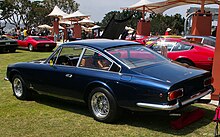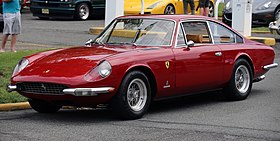
Ferrari 365

This article needs additional citations for verification. (May 2008) |
| Ferrari 365 | |
|---|---|
 Ferrari 365 GT 2+2 | |
| Overview | |
| Manufacturer | Ferrari |
| Production | 1966–1971
|
| Body and chassis | |
| Class | Grand tourer |
| Layout | Front-engine, rear-wheel-drive |
| Powertrain | |
| Engine | 4.4 L (4390.35 cc) Colombo V12 |
- See also Ferrari 365 GT4 2+2 & Ferrari 365 GTC/4 for later 2+2 models, and Ferrari Daytona for the 365 GTB/4 & GTS/4
The Ferrari 365 is a large front-engine, rear-wheel-drive 2- and 2+2-seater grand tourer produced by Ferrari. Introduced at the 1966 Geneva Motor Show, it replaced the 330 and 500 Superfast.

365 California

| Ferrari 365 California | |
|---|---|
 | |
| Overview | |
| Production | 1966–1967 14 produced |
| Designer | Tom Tjaarda at Pininfarina[1] |
| Body and chassis | |
| Body style | Convertible |
| Related | 500 Superfast |
| Powertrain | |
| Engine | 4.4 L Tipo 217B Colombo V12 |
| Dimensions | |
| Wheelbase | 2,650 mm (104.3 in) |
| Length | 4,900 mm (192.9 in) |
| Width | 1,780 mm (70.1 in) |
| Height | 1,330 mm (52.4 in) |
| Kerb weight | 1,320 kg (2,910 lb) |
The 365 California replaced the 500 Superfast for 1966. It was the first 365 model, with its 4.4 L (4390 cc/267 in³) V12 based on the 330's 4.0 L Colombo unit but with an 81 mm bore. This later version of the Colombo engine was rated at 320 horsepower, in street tune using three Weber carburettors.[2]

The 365 California used the same chassis as the 500 Superfast but with an evolutionary cabriolet body by Pininfarina. Debuting at the Geneva Motor Show in 1966, just 14 examples were produced[2] (including 2 in right hand drive) before production ended in 1967. Whilst the prototype was built on a 330 GT 2+2 type 571 chassis, production cars featured type 598 chassis. Chassis' were sent to Pininfarina's Grugliasco plant to be bodied and trimmed which were later returned to Ferrari to finish their mechanical components.

On 28 June 2005, a pristine 365 California sold for €736,000 (US$890,000).

365 GT 2+2

| Ferrari 365 GT 2+2 | |
|---|---|
 | |
| Overview | |
| Production | 1967–1971 800 produced |
| Designer | Aldo Brovarone at Pininfarina |
| Body and chassis | |
| Body style | 2+2 coupé |
| Powertrain | |
| Engine | 4.4 L Tipo 245 Colombo V12[3] |
| Dimensions | |
| Wheelbase | 2,650 mm (104.3 in)[3] |
| Length | 4,974 mm (195.8 in)[3] |
| Width | 1,786 mm (70.3 in)[3] |
| Height | 1,345 mm (53.0 in)[3] |
| Kerb weight | 1,480 kg (3,263 lb) (dry)[3] |
| Chronology | |
| Predecessor | Ferrari 330 GT 2+2 |
| Successor | Ferrari 365 GT4 2+2 |
The most popular 365 model was 1967's 365 GT 2+2, replacing the 330 GT 2+2. Unlike the 330 GT 2+2 car it replaced, which had a live rear axle on leaf springs, the 365 GT 2+2 had independent rear suspension.[3]

The 365 GT 2+2 was a luxurious car with leather seats, power steering and brakes, electric windows, and optional air conditioning. It quickly became the company's top-selling model with about 800 produced in four years, 52 of which were right hand drive. When leaving the factory the 365 GT 2+2 was fitted with Pirelli Cinturato 205VR15 tyres (CN72).

365 GTC and GTS
| Ferrari 365 GTC Ferrari 365 GTS | |
|---|---|
 | |
| Overview | |
| Production | 1968–1970 GTC: 168 produced GTS: 20 produced |
| Body and chassis | |
| Body style | GTC: 2-seat coupé GTS: 2-seat spider |
| Powertrain | |
| Engine | 4.4 L Tipo 245C Colombo V12[4] |
| Transmission | 5-speed manual all-synchromesh[5] |
| Dimensions | |
| Wheelbase | 2,400 mm (94.5 in)[4] |
| Length | 4,470 mm (176.0 in)[4] |
| Width | 1,670 mm (65.7 in)[4] |
| Height | 1,300 mm (51.2 in)[4] |
| Kerb weight | 1,350 kg (2,976 lb) (dry)[4] |
| Chronology | |
| Predecessor | GTC: Ferrari 330 GTC GTS: Ferrari 330 GTS |
| Successor | GTC: Ferrari 365 GTC/4 GTS: Ferrari 365 GTS/4 |
The 330 GTC and GTS were replaced in 1968 by the 365 GTC and GTS. It was essentially a re-engine of the 330 GTC/GTS, with the engine increasing from 4.0 liters and 300 horsepower to 4.4 liters and 320 horsepower.[6] The styling remained almost unchanged: on both body styles differences were limited to vents moved from behind the front wheels to the bonnet.

Like all 365s, the GTC and GTS were powered by a 4,390 cc Colombo V12 engine, specifically its Tipo 245/C variant. Fed by three twin-choke Weber 40 DFI carburettors,[5] it produced 320 PS (235 kW; 316 hp) at 6,600 rpm.[4] Integrating the gearbox with the final drive gave these cars a balanced 50:50 weight distribution. The 365 GTC and GTS retained the independent rear suspension, employing coil springs and wishbones, of its immediate predecessor. Brakes were servo-assisted discs all-round with a split circuit system.[5]

168 examples of the coupé were built (including 22 in right hand drive) between the 1968 and 1970. It was replaced by the Ferrari 365 GTC/4. Just 20 spiders were built before its place was assumed by the 365 GTB/4-based Daytona Spider.

References
- ^ "Cars by Tom Tjaarda". tom-tjaarda.net. Retrieved 11 June 2013.
- ^ a b "Ferrari 365 California". ferrari.com. Retrieved 7 June 2020.
- ^ a b c d e f g "Ferrari 365 GT 2+2". ferrari.com. Retrieved 19 July 2019.
- ^ a b c d e f g "365 GTC". Ferrari official site – Past models. Ferrari S.p.A. Retrieved 7 February 2016.
- ^ a b c "Autotest: Ferrari 365 GTC 4,390 c.c. Classic Italian thorough-bred. Superb V12 engine, electric performance, light brakes, excellent gearbox. Good ride. Handling better on dry roads than wet. Comfortable two seater, but needs better heating and ventilating system. In its class, a worthy machine". Autocar. 130. (nbr. 3824): 10–15. 29 May 1969.
- ^ Ahlgrim, Steve (December 2013). "1969 Ferrari 365 GTC". Sports Car Market. 25 (12): 50–51.
See what we do next...
OR
By submitting your email or phone number, you're giving mschf permission to send you email and/or recurring marketing texts. Data rates may apply. Text stop to cancel, help for help.
Success: You're subscribed now !
